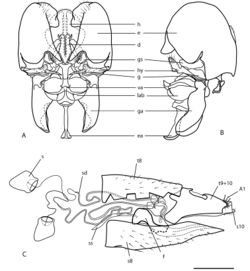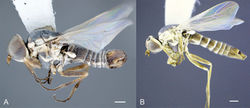Difference between revisions of "Heteromphrale cyanops"
(Created page with "__NOTOC__ '''Figure 3.''' ''[[Heteromphrale cyanops'' (Edwards). Male genitalia: '''A''' dorsal view '''B''' same lateral view...") |
|||
| Line 51: | Line 51: | ||
==Original Description== | ==Original Description== | ||
* {{aut|Winterton, SL}}; {{aut|Gaimari, SD}}; 2011: Revision of the South American window fly genus ''Heteromphrale'' Krober, 1937 (Diptera, Scenopinidae). [http://www.pensoft.net/journals/zookeys/ ''ZooKeys'',] '''84''': 39-57. {{doi|10.3897/zookeys.84.774}} [http://zoobank.org/?lsid=urn:lsid:zoobank.org:pub:9DB541F9-3F5B-4B95-B6A8-803E3E2A0B14 ZooBank] | * {{aut|Winterton, SL}}; {{aut|Gaimari, SD}}; 2011: Revision of the South American window fly genus ''Heteromphrale'' Krober, 1937 (Diptera, Scenopinidae). [http://www.pensoft.net/journals/zookeys/ ''ZooKeys'',] '''84''': 39-57. {{doi|10.3897/zookeys.84.774}} [http://zoobank.org/?lsid=urn:lsid:zoobank.org:pub:9DB541F9-3F5B-4B95-B6A8-803E3E2A0B14 ZooBank] | ||
| + | |||
| + | |||
| + | ==Other References== | ||
| + | *{{aut|Edwards, FW}} 1932: Scenopinidae, Mydaidae. ''Diptera of Patagonia and South Chile'' '''5''': 258-260. | ||
| + | *{{aut|Hardy, DE}} 1966: Family Scenopinidae (Omphralidae). In: Papavero N (Ed) ''A Catalogue of the Diptera of the Americas south of the United States''. Departamento de Zoologia, Secretaria da Agricultura, São Paulo, 32.1–32.5. | ||
| + | *{{aut|Kröber, O}} 1937: Ein Beitrag zur Kenntnis der Omphraliden (Scenopiniden), Diptera. ''Stettiner Entomologische Zeitung'' '''98''': 211-231. | ||
| + | *{{aut|Kelsey, LP}} 1969: A revision of the Scenopinidae (Diptera) of the world. ''Bulletin of the United States National Museum'' '''277''': 1–336. [http://www.biodiversitylibrary.org/item/33185 http://www.biodiversitylibrary.org/item/33185] | ||
Revision as of 13:13, 2 March 2011





Ordo: Diptera
Familia: Scenopinidae
Genus: Heteromphrale
Name
- Heteromphrale cyanops (Edwards) Wikispecies link
Pseudomphrale cyanops Edwards 1932: 259. – Kröber 1937: 212; Hardy 1966: 2.
Heteromphrale cyanops (Edwards) – Kelsey 1969: 286.
Type material
Holotype male, URUGUAY: Montevideo, 21.i.1927, F. & M. Edwards (MEI165200). (BMNH) (excellent condition).
Other material examined
ARGENTINA: Catamarca Province: 50 km W Andalgala, 31.X.1972, G.E. Bohart [1 male (UCDC)]; Andalgala, 4.XI.1972, G.E. Bohart, Prosopis alba [1 male (UCDC)]; 28 km SE Tinogasta, 1100 m, -28.2450°, -67.4557°, 17.X.1997, M.E. Irwin, F.D. Parker & S. Roig, ex. inland dunes [4 males (CSCA)]. La Rioja Province: Departamento Famatina, 12 km N Pituil, 4135 ft. [1260 m], -28°30'54.36, -67°20'20.04, 15.X.1997, M.E. Irwin, F.D. Parker & S. Roig, ex. Malaise trap [1 female (CASC), 1 female (CSCA)], ex. leaves of Prosopis tree [1 male (CASC)], 20.X.1997, ex. leaves of Prosopis tree [1 female (CASC)]. 16 km NE Pagancillo, Route 18, 28.XI.1976, ex. sweeping Prosopis chilensis [2 males (USNM)]. Mendoza Province: Departmento de Levalle, 20 km N Parque Telteca, -32.2916°, -67.3878°, 10.x.1997, M.E. Irwin, F.D. Parker, S. Roig, ex. Cerecidium blooms in sandy area [1 male (CASC)]. Salta Province: 10 km S Cafayete, 1644 m, -26°09.05', -65°57.31', 22–26.X.2003, M.E. Irwin & F.D. Parker, ex. Malaise trap in Prosopis-covered dunes [1 female (CASC), 1 female (CSCA)]. Tucuman Province: 8 km NW Amaichá del Valle, 1847 m, -26°32.35', -65°58.37', 22–25.X.2003, M.E. Irwin & F.D. Parker, ex. Malaise trap in ravine [1 female (CASC)].
Diagnosis
Antennal flagellum brown, conical and evenly tapered distally; mouthparts normal, nearly filling oral cavity; scutum without glabrous dorsocentral patches; wing with vein R4 diverging from vein R5 at point in basal quarter of cell r5; abdomen dark with pale posterior band on tergites 2–5; tergite 2 sensory patch relatively small, as single narrowed patch; male epandrium relatively large and bulbous, without distinctive white setal fringe along posterior margin; hypandrium small, lobes irregular; distiphallus arms parallel; lateral aedeagal bulb relatively large; female sternite 8 shallowly emarginate posteriorly, without fringing elongate setae; acanthophorite spines short and stout.
Redescription
Body length: 2.5–3.5 mm [male], 3.0–4.0 mm [female].
Head (Figs 4E–F, 5E–F). Frons, parafacial, face and gena cream-white to yellow (in female, with tan suffusion on frons, with median furrow), sparsely distributed with small, pale setae; ocellar triangle grey pubescent, slightly raised, with anterior ocellus slightly larger than posterior ocellus occiput and postgena dark, pale marginally with yellow suffusion; face white; mouthparts pale yellow, including labellum, labellar setae, and small cylindrical palpus; prementum pale yellow to slightly darker yellow; antennae with flagellum brown, evenly tapered; scape and pedicel pale brown-orange with a few minute pale setae.
Thorax (Figs 5E–F, 8). Scutum black to grey, cream-white to yellow areas on postpronotal lobe, anterior part of scutum adjacent to postpronotum, notopleuron, supra-alar area and postalar callus with slightly darker, thin, median stripe (more extensive in female in these areas, and additionally with yellow medially on posterior part of scutum, and a slight medial brownish mark extending from scutellum); thorax mostly overlain with dense glaucous pubescence; scutum largely without setae, some present on postpronotal lobe, anepisternum and katepisternum; scutellum dark medially, pale marginally; prosternum yellow, bare; proepisternum and proepimeron yellow, sometimes slightly darker on posterior part; anepisternum yellow in dorsal half and along posterior margin, grey pubescent anteroventrally; katepisternum grey pubescent, except yellow along entire dorsal margin; anepimeron yellow, usually with some grey pubescence anteriorly; meron grey pubescent, except yellow dorsally; coxae light brown; legs pale cream with uniform brown suffusion; basitarsi orange with slightly darker distal tip, and remaining tarsomeres dark orange.
Wing. Venation pale yellow; vein R4 diverging from R5 at point in basal quarter of r5; haltere with stem mostly brown, distal part of stem and entire knob white.
Abdomen (Fig. 8). Tergites dark brown pubescence with pale white band posteriorly; with pale setae, longer laterally; tergite 2 sensory patch small and inconspicuous, as single small, brown narrow patch, completely encompassed within dark brown pubescence; sternites white posteriorly, dark brown anteriorly and laterally; with sparse short pale setae.
Male genitalia (Figs 3, 10C). Epandrium robust, globose, dark orange, with sparse, small white setae; hypandrium lobes small, membranous, sub-triangular, each with two lobes directed posteromedially; gonocoxite with large, darkly sclerotized, anvil-like dorsal process; gonostylus complex, apparently fused to gonocoxites, outer lobe L-shaped with posteriorly directed margin fringed with setae, inner lobe triangular and fused medially; gonocoxal apodeme broadly flattened, and curved medially; ejaculatory apodeme relatively elongate, directed anteriorly; lateral aedeagal bulbs large; ventral apodeme dark sclerotized; distiphallus parallel, ventrally directed towards apex.
Female genitalia (Fig. 9G–I). Sternite 8 with posterior edge weakly emarginate, margin thin; acanthophorite spines stout.
Comments
Heteromphrale cyanops was originally described in the genus Pseudomphrale by Edwards (1932) based on a single male specimen from Uruguay. Edwards (1932) noted that the specimen was taken in a sandy spot near the shore, and also noted that the eye in life was deep blue in color; this eye color is retained in some specimens. Kelsey (1969) subsequently transferred the species to Heteromphrale. Heteromphrale cyanops is very similar to Heteromphrale blanca sp. n. in overall body coloration, but is easily distinguished from both other species of Heteromphrale by the greatly enlarged, bulbous epandrium in the male, the shallowly emarginate posterior edge of sternite 8 in the female, and by the tergite 2 sensory patch being a relatively small, singular, narrowed patch.
Distribution
Known from Argentina (Catamarca, La Rioja, Mendoza, Salta and Tucuman Provinces) and Uruguay (Montevideo Department).
Original Description
- Winterton, SL; Gaimari, SD; 2011: Revision of the South American window fly genus Heteromphrale Krober, 1937 (Diptera, Scenopinidae). ZooKeys, 84: 39-57. doi ZooBank
Other References
- Edwards, FW 1932: Scenopinidae, Mydaidae. Diptera of Patagonia and South Chile 5: 258-260.
- Hardy, DE 1966: Family Scenopinidae (Omphralidae). In: Papavero N (Ed) A Catalogue of the Diptera of the Americas south of the United States. Departamento de Zoologia, Secretaria da Agricultura, São Paulo, 32.1–32.5.
- Kröber, O 1937: Ein Beitrag zur Kenntnis der Omphraliden (Scenopiniden), Diptera. Stettiner Entomologische Zeitung 98: 211-231.
- Kelsey, LP 1969: A revision of the Scenopinidae (Diptera) of the world. Bulletin of the United States National Museum 277: 1–336. http://www.biodiversitylibrary.org/item/33185
